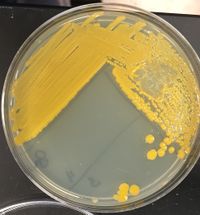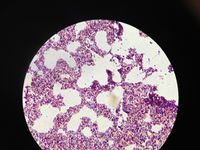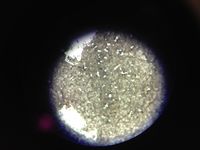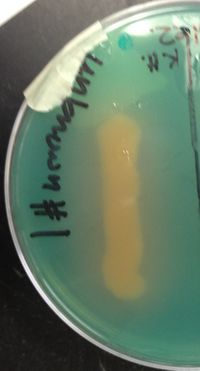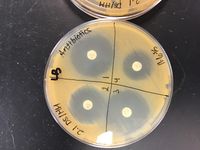Template talk:Genus hollingsworth: Difference between revisions
| Line 7: | Line 7: | ||
This soil organism was collected in the Hill Country of Fredericksburg, Texas. The soil was very soft and moist, about 5-6" in depth. | This soil organism was collected in the Hill Country of Fredericksburg, Texas. The soil was very soft and moist, about 5-6" in depth. | ||
''Exiguobacterium'' is found in the Siberian frost¹, glaciers in Greenland², Yellowstone National Park hot springs² and various other locations of extreme temperatures and conditions². | |||
==Description and Significance== | ==Description and Significance== | ||
Revision as of 00:31, 2 December 2015
Classification
Domain: Bacteria, Phylum: Firmicutes, Class: Bacilli, Order: Bacillales, Family: Bacillales Family XII. Incertae Sedis, Genus: Exiguobacterium, Species: Unknown
Habitat Information
This soil organism was collected in the Hill Country of Fredericksburg, Texas. The soil was very soft and moist, about 5-6" in depth.
Exiguobacterium is found in the Siberian frost¹, glaciers in Greenland², Yellowstone National Park hot springs² and various other locations of extreme temperatures and conditions².
Description and Significance
Our observation of Exiguobacteria is that they are small, irregular rod-shaped bacteria, or coccobacilli. Stains performed on our organism revealed a positive Gram stain and small capsules. This organism was negative for endospores. In regard to the colonies, our observation was that the colonies are yellow, shiny, round, and umbonate with a smooth, entire margin.
Collins, et al described Exiguobacterium in the following ways, "Cells vary in shape from rods (3.2 x 1.2 pm) in the exponential phase to short, almost coccoid forms (1-4 x 1.1 pm) in the stationary phase (Gee et al., 1980). Both rods and coccoid cells are Gram-positive..."³ They go on to say that, "Surface colonies on PPYG agar (Gee et al., 1980) are 2 to 3 mm in diameter after 3 d at 25 "C,low convex, orange, opaque, butyrous and easily emulsified...Orange pigment does not diffuse into medium; pigment production does not occur anaerobically."³ While we did not originally note that the colonies are opaque and butyrous and that the colony pigment did not diffuse into any of the mediums used when conducting tests on Exiguobacteria, we are in agreement with Collins, et al on these points.
The ability of Exiguobacterium to survive in extreme temperatures (-12C - 55C) and grow within a large range of pH (5-11) make this bacteria an important area of study. It has also shown to be tolerant of UV radiation and heavy metal stress.
Genome Structure
Describe the size and content of the genome. How many chromosomes? Circular or linear? Other interesting features? What is known about its sequence? Include S Ribosomal sequence that you obtained from PCR and sequencing here.
16S rRNA genome
GCACGCCGCGTGAGTGATGAAGGTTTTCNGANNGTAAAACTCTGTTGTAAGGGAAGAACACGTACGAGAGGAAATGCTCGTACCTTGACGGTACCTTACGAGAAAGCCACGGCTAACTACGTGCCAGCAGCCGCGGTAATACGTAGGTGGCAAGCGTTGTCCGGAATTATTGGGCGTAAAGCGCGCGCAGGCGGCCTTTTAAGTCTGATGTGAAAGCCCCCGGCTCAACCGGGGAGGGCCATTGGAAACTGGAAGGCTTGAGTACAGAAGAGAAGAGTGGAATTCCACGTGTAGCGGTGAAATGCGTAGAGATGTGGAGGAACACCAGTGGCGAAGGCGACTCTTTGGTCTGTAACTGACGCTGAGGCGCGAAAGCGTGGGGAGCAAACAGGATTANATACCCTGGTAGTCCACGCCGTAAACGATGAGTGCTAGGTGTTGGGGGGTTTCCGCCCCTCAGTGCTGAAGCTAACGCATNTANGCACTCCGCCTGGNGAGTACGGCCGCAAGGCTNAAACTCNAAGGANTTGACGGGGACCCGCACAATCGGGGGCACGCCGCGTGAGTGATGAAGGTTTTCNGANNGTAAAACTCTGTTGTAAGGGAAGAACACGTACGAGAGGAAATGCTCGTACCTTGACGGTACCTTACGAGAAAGCCACGGCTAACTACGTGCCAGCAGCCGCGGTAATACGTAGGTGGCAAGCGTTGTCCGGAATTATTGGGCGTAAAGCGCGCGCAGGCGGCCTTTTAAGTCTGATGTGAAAGCCCCCGGCTCAACCGGGGAGGGCCATTGGAAACTGGAAGGCTTGAGTACAGAAGAGAAGAGTGGAATTCCACGTGTAGCGGTGAAATGCGTAGAGATGTGGAGGAACACCAGTGGCGAAGGCGACTCTTTGGTCTGTAACTGACGCTGAGGCGCGAAAGCGTGGGGAGCAAACAGGATTANATACCCTGGTAGTCCACGCCGTAAACGATGAGTGCTAGGTGTTGGGGGGTTTCCGCCCCTCAGTGCTGAAGCTAACGCATNTANGCACTCCGCCTGGNGAGTACGGCCGCAAGGCTNAAACTCNAAGGANTTGACGGGGACCCGCACAATCGGGG
Cell Structure, Metabolism and Life Cycle
Interesting features of cell structure; how it gains energy; what important molecules it produces.
Exiguobacteria are facultative anaerobes and fermentative in their metabolism. This organism ferments glucose and mannitol but not sucrose or lactose. Cell structure composed of Peptidoglycan de-amino acid, L-Lysine. This organism is positive for menaquinone MK-7, a form of Vitamin K produced by bacteria in the intestine that is important for blood clotting. Cellular fatty acids include C17;Oi, C15;Oi, C16O.
Physiology and Pathogenesis
Biochemical characteristics, enzymes made, other characteristics that may be used to identify the organism; contributions to environment (if any).
If relevant, how does this organism cause disease? Human, animal, plant hosts? Virulence factors, as well as patient symptoms.
Gelatin Hydrolysis: gelatinase negative (Collins, et al noted the organism to hydrolyze gelatin.¹ )
DNA Hydrolysis: DNase positive
Lipid Hydrolysis: lipase negative
Phenol Red Broth:
Starch Hydrolysis: alpha-amylase positive
Casein Hydrolysis: casease positive
Methyl Red: positive for mixed acids
Voges-Proskauer: negative
Citrate: negative
SIM: sulfur reduction - negative, indole reaction - negative, motility - light, feathery growth which indicates a weak positive
Nitrate Reduction: does not reduce nitrate (Collins, et al noted the organism to reduce nitrate to nitrite.¹ )
Urea Hydrolysis: negative
Triple Sugar Iron: positive glucose and lactose fermentation, does not reduce sulfur (Other tests showed this organism to not ferment lactose. This test is an outlier on this topic.)
Decarboxylation: does not produce decarboxylase
Phenylalanine Deaminase: negative
Oxidase: negative
Eosin Methylene Blue Agar: negative
Hektoen Enteric Agar: negative
MacConkey Agar: negative
Catalase: positive
Blood Agar: gamma hemolysis
Mannitol Salts Agar: growth, weak positive for mannitol fermentation
Phenylethyl Alcohol Agar: growth, confirms that organism is Gram positive
Bacitracin/Optochin Susceptibility: not susceptible to bacitracin or optochin
Bile Esculin: hydrolyzes esculin
6.5% Salt Tolerance: negative
Kirby-Bauer Antimicrobial Susceptibility Tests for disinfectants: strongly susceptible to bleach, lysol, and lavender but only weakly susceptible to tea tree oil
Kirby-Bauer Antimicrobial Susceptibility Tests for antibiotics: strongly susceptible to ampicillin, linezolid, ticarcillin/clavulanic acid, and ceftazidime
Enzymes cleansed from exiguobacterium samples are alkaline protease, EKTA catalase, guanosine kinase, ATPases, dehydrogenase, and esterase. http://www.vp-scientific.com/reference-pdf/Extremophiles-2009-Vishnivetskaya.pdf
This bacteria has possible antimicrobial activity in that at least one of the species may aid in the digestion of plastics by mealworms. http://www.ncbi.nlm.nih.gov/pubmed/26390390
One species (Exiguobacterium sibiricum) may cause human skin infection. http://www.ncbi.nlm.nih.gov/pmc/articles/PMC4257833/
Other strains of exiguobacterium are known to promote growth in plants. http://www.ncbi.nlm.nih.gov/pmc/articles/PMC3299478/
In 2005, a documented case of an elderly woman with a hospital-acquired (acetylicum) exiguobacterium infection following a long hospital stay and need for catheter care while inpatient. Her symptoms included urinary retention, fever, tachycardia and leukocyturia. She was treated with cefuroxime. http://jmm.microbiologyresearch.org/content/journal/jmm/10.1099
References
¹Qiu, Yinghua, Sophia Kathariou, and David M. Lubman. "Proteomic Analysis of Cold Adaptation in a Siberian Permafrost Bacterium – Exiguobacterium Sibiricum 255–15 by Two-dimensional Liquid Separation Coupled with Mass Spectrometry." Proteomics 2006.6 (2006): 5221-233. University of Michigan Library. WILEY-VCH Verlag GmbH & Co. KGaA, Weinheim. Web. 2 Dec. 2015.
²Vishnivetskaya, Tatiana A., Sophia Kathariou, and James Tiedje. "The Exiguobacterium Genus: Biodiversity and Biogeography." Extremophiles 13.May 2009 (2009): 541-55. Web. 1 Dec. 2015. <http://link.springer.com/article/10.1007/s00792-009-0243-5>.
³Collins, M.D., B.M. Lund, J.A.E. Farrow, and K.H. Schleifer. "Chemotaxonomic Study of an Alkalophilic Bacterium, Exiguobacterium Aurantiacum Gen. Nov., Sp. Nov." Journal of General Microbiology 129.7 (1983): 2037-042. Microbiology Society. Microbiology Society. Web. 1 Dec. 2015.
http://www.bacterio.net/exiguobacterium.html
Koneman's Color Atlas and Textbook of Diagnostic Microbiology, edited by Elmer W. Koneman, Google Books
Author
Page authored by Danielle St.Romain and Heather McMillion, students of Prof. Kristine Hollingsworth at Austin Community College.
